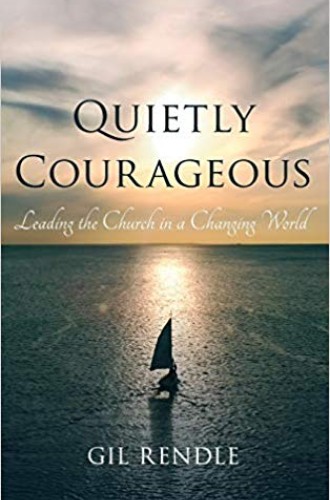A radically new vision of mainline church leadership
Helping people think differently in changing times
“What are the issues that the church must confront?” I ask seminarians. “Sexism.” “Racism.” “Poverty,” they call out. I reply dramatically, “None of that will change without someone taking responsibility, stepping up, and leading.” But what kind of leadership is needed?
After a lifetime of consultative work with Protestant, Catholic, and Jewish systems around the world, Gil Rendle packs everything he’s learned into the decade’s best book on church leadership. Quietly Courageous opens with, “The established institutional church cannot now thrive on the good leadership it currently has.” Pastors must learn to embody “quiet, courageous, purposeful leadership.”
Read our latest issue or browse back issues.
According to Rendle, most pastors grew up in a convergent culture—one characterized by commonality of purpose, a sense of unity, and shared values. Those same pastors are now called to lead in a divergent culture—one that celebrates variety, expresses diversity, and stresses differences. Mainline church leadership was easy in a convergent culture, Rendle writes, because “it isn’t difficult to lead people in the direction they are already going.” At some point, though, people stopped saying, “We’re here because my family has always been Methodist.” They began saying, “Show us what your church can do for us or we’re walking.”
In a divergent culture, institutions are voluntary conglomerations of individuals without a common commitment. Advertising encourages us to fulfill individual needs. Technology enables us to live in the functional equivalent of gated communities without shared purpose or dreams. Agreement and consensus are unrealistic goals. Voting and majority rule don’t work. Courageous, intentional muddling through is sometimes the best we can do.
Acknowledging his indebtedness to Ron Heifetz’s work on adaptive leadership, Rendle says that the pastoral task is no longer to motivate people to move from point A to point B. It’s to help people undertake the adaptive challenge: reconceiving and then undertaking the work they are called to do. Like Heifetz, Rendle portrays leadership as an educational activity in which the leader helps an organization think differently and realistically about its condition. Yet more than Heifetz, Rendle stresses the courage that rethinking and truth telling require.
In the face of perplexity, Rendle says, leaders must recognize the difference between a problem and a condition. If a situation doesn’t have a specific answer, it’s not a problem; it’s a condition. Peter Steinke has taught that the greater the anxiety in a congregation, the more they will misdiagnose their condition and look to pastoral leaders for simple fixes that promise to reduce their anxiety. As a bishop, I found that most congregations want a new pastor who will miraculously and painlessly fix their problems when what they need is a leader who is a learner with enough courage to help them acknowledge and creatively respond to their true condition.
The courageous leader connects an organization to its pain, helps it conceive of its possibilities, challenges it to step out of attitudes that rob it of a future, accompanies it through the resulting anxiety and chaos, and supports the learning that occurs through the adaptive work.
Bucking the trend in leadership books that focus upon contextual factors and organizational strategies, Rendle emphasizes what needs to happen in the soul of the leader. Church leaders cannot create or control change, but we can learn to manage ourselves as the congregation muddles through change. We can disturb, push, disrupt, tell the truth, help the congregation acknowledge and endure pain, and thereby give them the possibility of forward movement.
None of this is easy. Organizations tend to reward ministry that’s limited to internal maintenance. They don’t want their leaders to undertake the difficult work that causes pain. But someone needs to love the congregation enough—and be sufficiently obedient to Christ’s mission—to introduce disturbance. While it’s tempting to comfortingly assist in the congregation’s collective denial and self-deceit, Rendle says, pastors who do so are forsaking their prophetic calling.
He echoes Janice Huie’s criticism of the excessive caregiving and personal support offered to seminarians, which serve to foster an overly empathetic style of ministry that creates dependency and empowers wounded people to dominate the congregation. When a pastoral leader aspires to be no more than a caregiver (or, as Stanley Hauerwas has put it, a “quivering mass of availability”), the congregation’s weakest members will sabotage the ministry. Rendle cites Edwin Friedman’s attack on undisciplined pastoral empathy: when people say that you are cruel, autocratic, and uncaring, “there is a good chance you’re going in the right direction.”
Rendle is also unimpressed with seminary and denominational attempts to teach leadership. Seminaries offer information, skills, and insights. They don’t help future pastors move beyond being talented but tenuous. The best way for pastors to become quietly courageous leaders, he believes, is through small, long-term, trusting peer groups of pastors who intentionally examine their leadership with a commitment to growth.
Like many church leadership books, Quietly Courageous gives scant theological rationale for leading change. Rendle declares, “Anxiety need not be relieved; it does need to be mobilized for a purpose.” But he fails to note that the demands placed upon the church by God are the greatest source of tension—and of potential empowerment.
God calls us not only to be in relationship with one another but also to join in God’s mission to the world. As Aquinas told priests of his day, God promises to equip those whom God calls. A good deal of pastoral courage is induced by the Holy Spirit. The Christian leader dares to tell the truth because of a conviction that Christians have been given knowledge of who God is and what God is up to. That knowledge gives purpose to the church and its ministry beyond even the savviest leadership books.
Whatever God wants done in the world, God refuses to do it alone. Thus, God gives us the church and its pastors. If what Rendle says about the need for quietly courageous leaders is true—and I think it is—there’s no way to have such leaders except by way of a God who enjoys giving ordinary people outrageously difficult assignments.
The week after my denomination failed to figure out how to be in ministry with LGBTQ Christians, I talked with a group of hurt, angry seminarians. Some said, “This is it for me and the United Methodist Church. I’m out.” Another student emerged from that meeting with clenched fists, a determined jaw, and a vow: “I’m not giving up. I’m going to prove that Jesus knew what he was doing when he drafted me for the UMC.”
I replied, “I’ve got just the book to show you how.”







